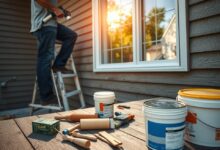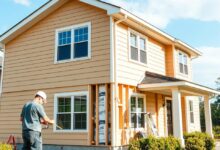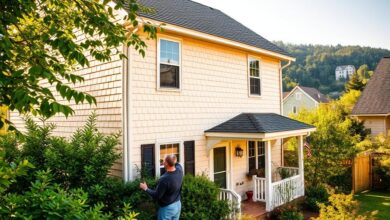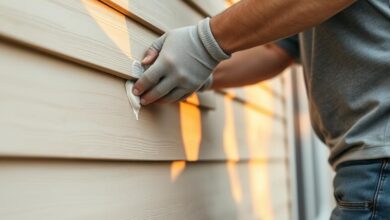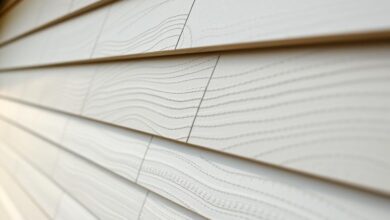How to Install Long Lasting Insulated Siding
Upgrading your home’s exterior with insulated siding can make it more energy-efficient and attractive. It acts as a strong shield against weather, keeping your home warm in winter and cool in summer.
Getting it right is key to enjoying long lasting insulated siding. A well-installed siding can protect your home for many years, saving you money on repairs and upkeep.
This article will show you how to install insulated siding. We’ll cover the tools, materials, and techniques you need for a successful job.
Key Takeaways
- Understand the benefits of insulated siding for your home.
- Learn the importance of proper insulated siding installation.
- Discover the necessary tools and materials for the project.
- Gain insights into the installation process.
- Identify common mistakes to avoid during installation.
The Benefits of Long Lasting Insulated Siding
Long lasting insulated siding is gaining popularity. It offers many benefits, like saving energy and lasting longer. Homeowners see its value for their homes.
Overview of Insulated Siding Technology
Insulated siding is a big step forward in building materials. It mixes traditional siding with insulation. This makes homes more energy-efficient and durable.
This technology keeps the inside of your home at a steady temperature. It blocks heat from moving in or out.
Energy Efficiency Improvements
One key benefit of insulated siding is saving energy. It keeps your home warm in winter and cool in summer. This can cut down your heating and cooling bills by up to 20%.
Structural Reinforcement Benefits
Insulated siding also strengthens your home’s structure. The insulation makes the siding more solid. It can withstand wind and other damage better.
This means your siding lasts longer and needs less repair. It saves you money in the long run.
Noise Reduction Properties
Another advantage of insulated siding is it reduces noise. The insulation blocks outside sounds. This makes your home quieter and more peaceful.
Knowing these benefits helps homeowners choose better siding. They can get homes that are more energy-efficient, durable, and comfortable.
Top Types of Long Lasting Insulated Siding
The market offers a variety of long-lasting insulated siding options. Each has its own benefits and drawbacks.
Vinyl Insulated Siding
Vinyl insulated siding is a favorite among homeowners. It’s durable and easy to maintain. It combines vinyl siding with insulation for better energy efficiency.
Features and Specifications
Vinyl insulated siding has a foam backing for better thermal performance. It comes in many styles and colors, fitting various architectural designs.
Pros
- Durability: Resistant to weathering and pests.
- Low Maintenance: Easy to clean and maintain.
- Energy Efficiency: Reduces heat transfer, lowering energy bills.
Cons
- Initial Cost: Higher upfront cost compared to some other siding types.
- Environmental Impact: Made from non-biodegradable materials.
Fiber Cement Insulated Siding
Fiber cement insulated siding is highly regarded. It’s strong and resistant to fire and pests. It’s made of cement, sand, and cellulose fibers.
Features and Specifications
This siding is durable and can be painted to match any home design. It also has high insulation when paired with the right backing.
Pros
- Durability: Highly resistant to damage from pests and weathering.
- Fire Resistance: Non-combustible, making homes safer.
- Aesthetic Flexibility: Can be painted to suit any design.
Cons
- Weight: Heavier than some other siding options, requiring additional structural support.
- Installation Challenges: More difficult to install due to its weight and material characteristics.
Engineered Wood Insulated Siding
Engineered wood insulated siding offers a natural look with enhanced performance. It’s made by layering wood fibers in different directions. This improves its stability and resistance to warping.
Features and Specifications
This siding is known for its aesthetic appeal and can be treated for durability. It can also be paired with insulation for better energy efficiency.
Pros
- Natural Appearance: Offers a traditional wood look without the high maintenance.
- Stability: Less prone to warping or shrinking.
- Sustainability: Made from renewable wood resources.
Cons
- Moisture Sensitivity: Can be damaged by excessive moisture if not properly treated.
- Cost: Can be more expensive than some other siding options.
Complete Installation Guide for Long Lasting Insulated Siding
To get a durable and energy-saving exterior, follow this detailed guide on installing insulated siding. It covers key steps for a professional look and the most from your siding.
Preparation Phase
Required Tools and Materials
First, collect all needed tools and materials. You’ll need insulated siding panels, a moisture barrier, starter strips, corner posts, and fasteners. Having everything ready will make the process smoother and faster.
Wall Preparation and Inspection
Check the exterior walls for damage or rot. Fix any issues before starting. Make sure the walls are clean, dry, and free of debris for a solid base.
Measure the walls to figure out how many siding panels you’ll need. Plan the layout to avoid cuts and look good. Think about windows, doors, and other features that might affect the siding.
Installation Process
Installing Moisture Barrier
Put a moisture barrier on the walls to keep water out. This step is key for wall integrity and siding longevity.
Starter Strip Attachment
Put the starter strip at the wall’s bottom edge. Make sure it’s level and fastened well. This strip helps the first row of siding panels.
Panel Installation Techniques
Start with the siding panels from the bottom up. Make sure each panel is fastened well and aligned right. Use a level for plumb and a tape measure for spacing.
Corner and Trim Work
Install corner posts and trim around openings. These add to the look and protect against the weather.
Finishing Touches
Sealing and Caulking
Seal gaps around windows, doors, and joints with caulk. This stops water and boosts energy efficiency.
Final Inspection Points
Do a final check to make sure panels are on tight and seams are sealed. Look for any gaps or misalignments to fix.
Maintenance and Performance of Insulated Siding
Keeping your insulated siding in top shape is key. Regular checks and care can extend its life and keep it working well. This way, your siding will last longer and perform better over time.
Cleaning and Regular Maintenance
It’s important to clean your insulated siding often. This removes dirt and debris that can harm it. Use a mild soap and a soft brush to clean it, then rinse with water from a hose. Also, check it regularly for any signs of trouble.
Durability and Weather Resistance
Insulated siding is built to last and handle different weather. But, very bad weather can cause damage. Knowing how your siding handles weather helps you get ready for and deal with weather problems.
Repair Techniques for Minor Damage
For small issues like cracks or dents, you can fix them with special materials and methods. It’s important to fix these problems quickly to stop them from getting worse.
Long-Term Performance Expectations
The life of insulated siding depends on many things. These include how well it was installed, how it’s maintained, and the local weather. If you take good care of it, insulated siding can last a long time. It will keep your home energy-efficient and safe.
Recommendations for Different Climates
Different places have their own weather challenges for insulated siding. For example, near the coast, siding needs to fight off salt damage. In very cold or hot places, siding must handle big changes in temperature. Knowing these challenges helps you pick the right siding and care for it.
Conclusion
Long lasting insulated siding brings many sidings benefits. It improves energy efficiency and adds strength to your home. Knowing the different types and how to install them makes your home’s exterior durable and easy to care for.
This siding cuts down on energy costs and noise. It’s a great choice for anyone wanting to improve their home’s look. But, it’s important to keep it up to ensure it works well for a long time.
Choosing the right insulated siding and following the right installation and care steps is key. This way, you get a beautiful, energy-saving home that lasts for many years.



